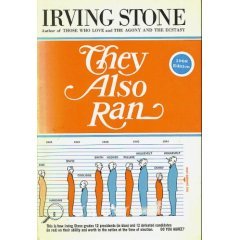Irving Stone’s They Also Ran, 2nd edition book jacket

They Also Ran, from Irving Stone, was a book originally published in 1943, but re-published — according to wikipedia in 1966, but the cover above is for the edition published in 1947, and 1964, and the 1966 edition apparently had its paperback reprint in 1968.
I mention it, and post that cover, for the simple fact that I quite like that cover. I only wish the back-cover for this wrap-around were available to complete the effect. The wrap-around cover for the original is online, though not all that interesting — better to browse through and get lost in the covers for a website that its on. The cover for the final paperback edition is moderately interesting, but probably would get lost in any book shuffle.
The amazon.com review on the cover.:
Now, I am going to do something that I think is rare, if not unique, in these book reviews. I’m going to devote most of the rest of this review to the dust jacket. Across the dust jacket there is a graph consisting of 21 lines ranging from minus ten (-10) to plus ten (+10). In case you’re wondering, the twenty-first line is the zero (0) line in the middle. Stone refers to this zero line as “the danger line,” i.e. a candidate in the negative zone may well do more harm than good if he wins the presidency. The graph rates the winners and losers of twelve elections according to Stone’s estimation of each man’s “ability and worth to the nation at the time of the election.” The candidates are represented by silhouettes having their heads at one of the lines. For clarity and consistency, the winners are in white and the losers in outline form. It is interesting to note that the lower ranked in some years are sometimes ranked higher than either the winner or loser in other years.
Some interesting evaluations:
Highest ranked winner in any year: Abraham Lincoln (+10) in 1860. His opponent, Stephen A. Douglas had a (+1) ranking.
Lowest ranked winner in any year was Warren Harding (-9) in 1920. His opponent who lost the election was James M. Cox who was rated at (+3).
Most evenly rated election: 1928 when winner, Herbert Hoover and loser, Alfred E. Smith were both rated (+5).
In three elections the winner fell into Stone’s “danger zone.” These were: 1856, James Buchanan (-1); 1872, Ulysses S. Grant (-5); and 1920, Warren Harding (-9).
Of the twelve elections on the graph, according to Stone’s ratings, the man more valuable to the country at the time the election was held won six times and lost five times. In the twelfth election the candidates were considered evenly qualified.
Response:Â
Many historians consider the elections of 1856 and 1872 to be the “No Good Choice” elections, in which the American people were offered two bad choices and asked to pick between them- Fremont v. Buchanan in 1856, Grant v. Greeley in 1872. Stone considers the elections in which Clay and Bryan were defeated as “no brainers,” as he considered both Clay and Bryan either frighteningly ambitious or ignorant.
Stone also points to elections like 1880 (Garfield v. Hancock) and 1920 (Cox v. Harding) as “no brainers” in which the obviously inferior candidate won. I agree in the case of 1920, but think Stone treats Garfield a bit unfairly, as we never do get to find out how good a President he could have been.
Finally, the election of 1928 is generally accepted as one in which two very superior candidates were offered to the American people, making for a very tough choice to be made in a sad climate of anti-Catholic, anti-Immigrant smears.
I suppose Irving Stone’s game is even more of a mug-shot than ranking presidents. Â The man hates Henry Clay and William Jennings Bryan with a disarming passion, and holds Samuel Tilden and Horatio Seymour to a jarringly hagiographic level.
If you read the first edition and the second edition, you’ll see some paragraphs of Wendell Willkie picked up and transposed to cover Thomas Dewey — “the only one of the presidential also rans who might run again”. Indeed, Dewey did. And lost. Ironically after Irving Stone posited that “America will go for the Underdog in Sports, but not for the President.” Willkie, naturally, was never liked by the Republicans who nominated him — and felt someone put him over on them, and was never going to be nominated again.
I suspect that Stone would pair Dewey alongside Nixon in a “Young Man in a Hurry” category — the only problem being one of close chronology. With all due respect to Stevenson and Goldwater, the remaining contender Stone focused on — Nixon is the only one I really want to know where Stone decided — basically because I suspect he’d have written unintentionally hilarious stuff in consideration of Nixon. (And probably the same with Kennedy, now that I think about it.)
August 12th, 2012 at 2:42 pm
I agree. He hates Henry Clay with a passion, but I have to agree with his assessment of William J. Bryan, who would have been as bad a President as any right wing Republican conservative today who wants everyone to be a staunch Bible-thumping Christian.